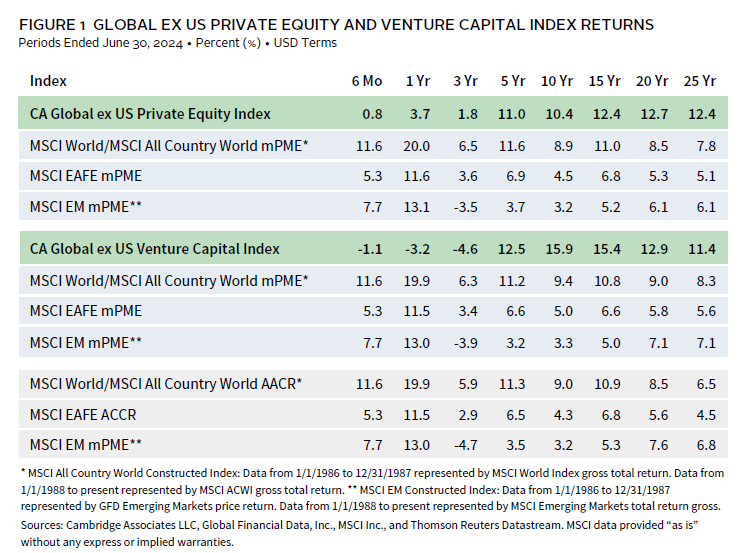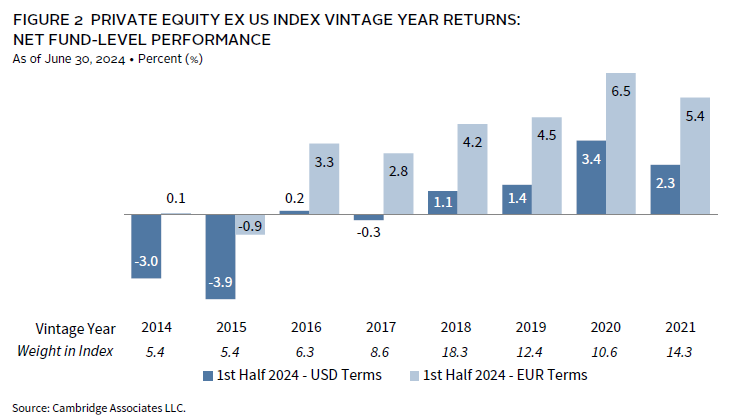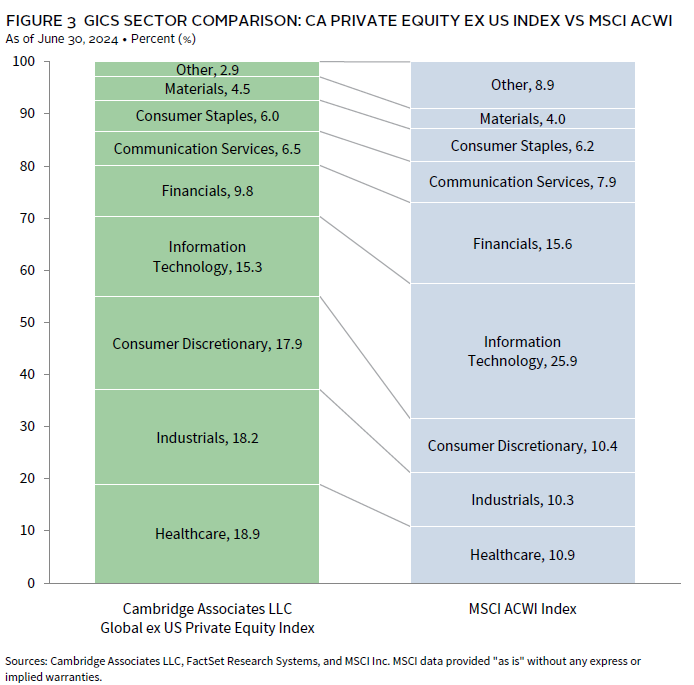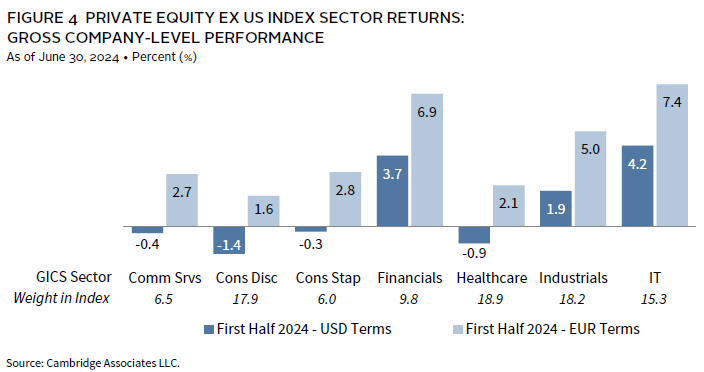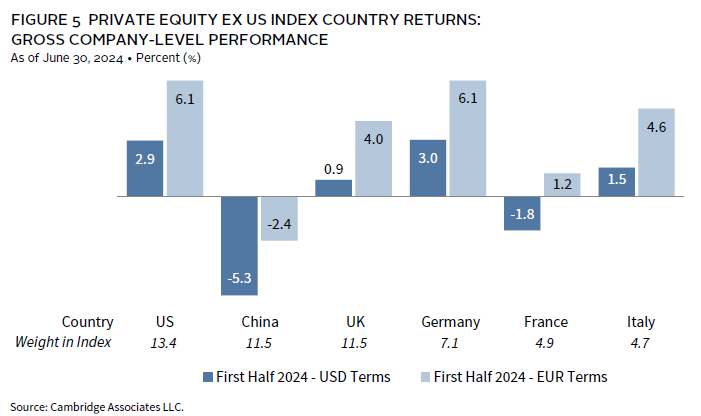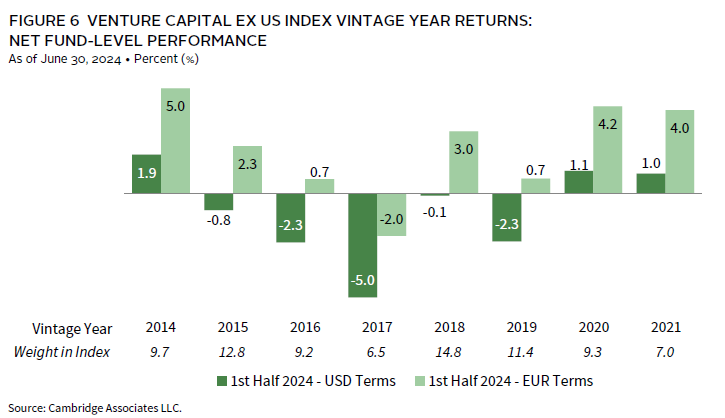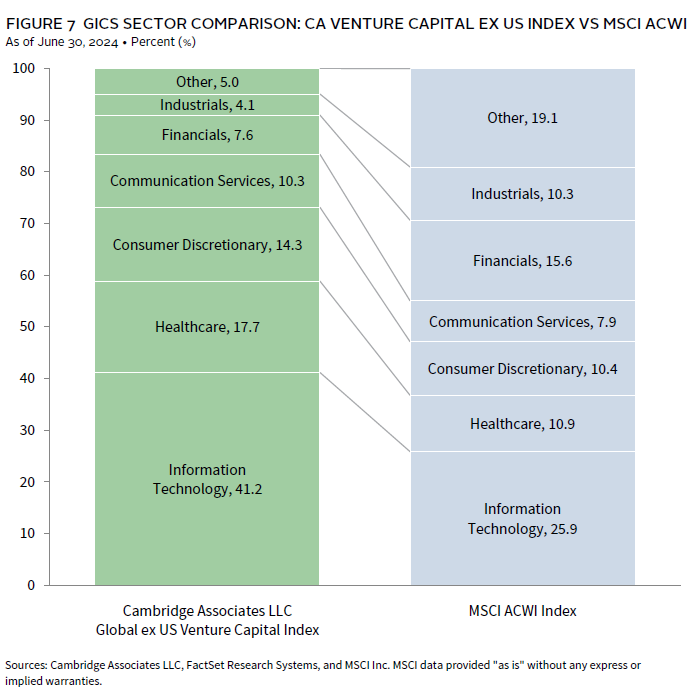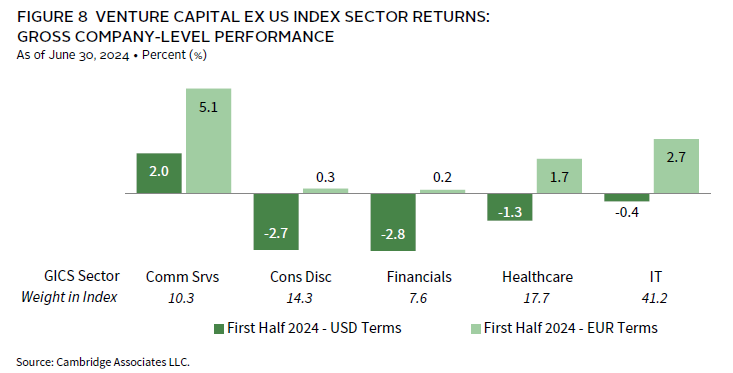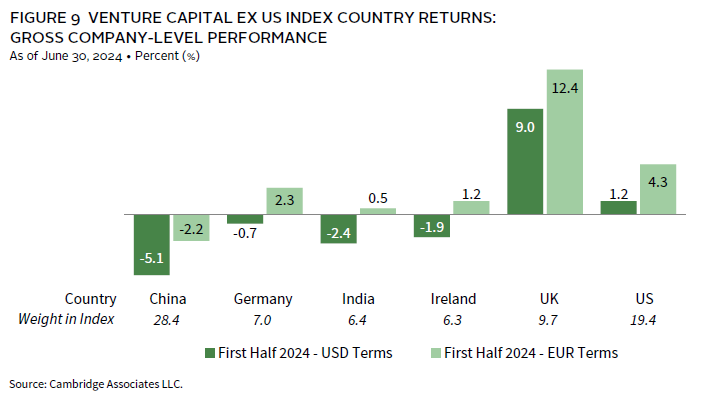Private equity (PE) outperformed venture capital (VC) in global ex US markets in the first half of 2024, just as it did in the United States, with the Cambridge Associates LLC Global ex US Private Equity Index returning 0.8% and the Cambridge Associates LLC Global ex US Venture Capital Index losing -1.1%, both in USD terms. The strong US dollar led to better returns when measured in euros; the PE index earned 3.8% and VC earned 2.0%. With a weak first half, venture’s downward trend was extended to the three-year horizon return (Figure 1). While the global ex US PE/VC indexes have historically outperformed their public market counterparts (based on modified public market equivalent [mPME] returns), the most recent three years stand out as an exception.
First Half 2024 Highlights
- The global ex US PE index earned better returns than its VC counterpart, but private asset classes were bested by public markets. In general, less mature vintage years outperformed older ones, while sector performance was mixed.
- Historically, the VC index has had a larger exposure to public companies—a trend that held in 2024. Based on market values at June 30, 2024, public companies accounted about 11% of the global ex US VC index and about 5% the global ex US PE index.
Global ex US Private Equity Performance Insights
Vintage Years
Returns were mixed across key vintage years (those that represented at least 5% of the index’s value) in the global ex US PE index during the first six months of 2024. Older funds from 2014–17 posted flat-to-negative results, while newer funds from 2018–21 earned positive returns (Figure 2). US dollar strength meant returns were considerably better when measured in euro terms. The 2018 vintage remained the largest at 18.3% of the index, but 2021 funds already accounted for 14.3%—a figure that will likely increase as more capital is deployed. Combined, the key vintages represented 81% of the index’s value and returned about 0% in USD terms and 4% in euro terms.
The best-performing vintage year, 2018, earned 1.1% in the first half of the year, driven primarily by investments in industrials, information technology (IT), and financials. Funds from 2015 had the worst performance over the same period. The vintage year experienced negative returns across all sectors except those considered more “recession resilient,” including industrials and consumer staples.
Limited partner (LP) cash flows showed signs of recovery in the first six months of 2024 after a distribution drought the prior year. While still low in absolute terms, distributions outpaced contributions $30 billion to $28 billion, respectively. This pace puts distributions about equal to the prior year’s levels with contributions falling meaningfully short.
Funds started from 2020 to 2023 accounted for almost 80% of the capital called in the first half of the year. The 2023 vintage called the most, 24%, which is typical for younger funds in the peak of their investment period. More surprisingly, the second largest vintage was 2021, which accounted for 21% of all capital called despite being over three years old. 2021 was a record-breaking time for fundraising and funds from that year continue to have an outsized impact on the benchmark. Older vintage years (2016–19) returned more than $17 billion, representing 60% of all distributions. While still relatively young, funds from 2020 and 2021 accounted for less than 10%; these vintages invested most of their capital during peak valuations and continue to face a challenging exit environment.
Sectors
Figure 3 shows the Global Industry Classification Standard (GICS®) sector breakdown of the global ex US PE index and a public market counterpart, the MSCI All Country World Index (ACWI). The chart illustrates differences in sector exposures, which helps explain relative performance. The PE index has considerably less exposure to IT and financials, and more to healthcare, industrials, and consumer discretionary.
All seven meaningfully sized sectors earned positive returns in the first two quarters when measured in euros, but performance was less uniform when measured in USD (Figure 4). Returns for IT, financials, and industrials were positive, while for the rest, including the largest sector (healthcare), results were negative. Collectively, the key sectors posted a pooled gross return of 1% in USD and 4% in euro terms.
The two largest sectors by weight—healthcare and industrials—garnered the most capital in the first half of the year. Both represented about 18% of the index, but each accounted for almost 30% of money invested. IT, however, only took in 8% of the capital despite being the third largest sector (15.3%). The move away from IT and into healthcare and industrials is consistent with the broader “risk-off” sentiment and pivot to value investing evident over the last couple of years.
Countries
Like vintage years and sectors, country-specific returns ranged considerably. China, which represents 11.5% of the global ex US PE index, posted a -5.3% return in USD terms. Meanwhile, the next two largest countries (the United States and the United Kingdom) earned positive returns (Figure 5). The smaller European countries also had mixed performance, ranging from -1.8% for France to 3% for Germany-based companies. These returns reflected general market conditions during the first half of 2024 when the US economy proved strongest while Europe lagged, and Asia struggled. Combined, the pooled gross return for all six countries was 0% (USD) and 3% (EUR).
Despite the global ex US makeup of the funds in the index, companies based in the United States garnered the most capital (10%) of the meaningfully sized countries. China only accounted for 7% of inflows despite being the second largest country in the index. Meanwhile, Japan and South Korea received 17% and 12%, respectively, which is well above their long-term norms of 2%. This could be a sign that China’s economic headwinds are leading investors to reallocate within Asia.
Global ex US Venture Capital Performance Insights
Vintage Years
As of June 30, 2024, eight vintage years in the global ex US VC index were meaningfully sized (those that represented at least 5% by capital weight) and accounted for more than 80% of the index’s value (Figure 6). In USD terms, performance ranged from -5.0% for funds with a first cash flow in 2017 to 1.9% for 2014 funds; returns were slightly better when measured in EUR terms, with 2017 and 2014 funds returning -2.0% and 5.0%, respectively.
Performance for the best-returning vintage year, 2014, was primarily driven by write-ups in its largest sector, IT, which were partially offset by modest write-downs in healthcare. On the other hand, performance for 2017 funds was pulled lower by write-downs across sectors, including consumer staples, financials, and healthcare. The largest vintage year, 2018, represented nearly 15% of the index and posted a return of -0.1%, driven by mixed performance its two largest sectors: healthcare and IT.
In the first half of 2024, VC funds outside the United States called $3.4 billion and distributed $3.7 billion, a 7% increase and an 8% decrease from the prior period, respectively. However, on an annual basis, 2024 cash flows are on a similar pace from the prior year. Contributions and distributions have been considerably lower since the beginning of 2022 as venture continues to reset from the covid-era frenzy.
Almost 80% of the capital called in the first six months was from managers that started investing funds in 2020–22, with nearly 70% coming from 2021–22; the latter two vintages called $1.0 billion and $1.3 billion, respectively. Distributions were more widespread, with six vintages accounting for nearly 70% of total flows back to LPs, each returning at least $300 million to investors. Funds from 2014 and 2018 returned the most capital to investors, with each accounting for about 15% of the total for the period.
Sectors
Figure 7 shows the GICS® sector breakdown of the global ex US VC index and a public market counterpart, the MSCI ACWI. The chart highlights a few significant overweights in the global ex US VC index, including in the IT, healthcare, and consumer discretionary sectors. The private market underweights are most significant in financials and industrials, respectively, as well as in consumer staples and materials (which are included in the “Other” category).
Four of the five meaningfully sized sectors posted negative returns in USD terms in the first half (Figure 8). Communication services (2.0%) was the best-performing sector, followed by IT (-0.4%). The two worst-performing sectors, consumer discretionary and financials, returned -2.7% and -2.8%, respectively. The positive performance for communication services was driven by funds in the 2006 and 2012 vintages, as results for the sector were mixed across other vintages. Consumer discretionary investments were written down across a wide swath of vintages, while performance for the financials sector was pulled down primarily by funds formed in 2017 and 2021. Returns for all sectors were better when measured in EUR terms. On a gross, dollar-weighted basis, the three largest sectors by market value—IT, healthcare, and consumer discretionary—accounted for 73% of the index and together returned -1.1% on a pooled basis, just below that of the other two meaningfully weighted sectors.
Companies in IT, healthcare, and consumer discretionary garnered 78% of the capital invested during the first half of 2024. Since the inception of the index, managers have allocated 73% of capital to these three sectors. The discrepancy is primarily due to an increased allocation to healthcare (39% compared to 26% long term), offset somewhat by a decreased allocation to consumer discretionary (4% compared to 11% long term).
Countries
China was the largest country in the global ex US VC index by a considerable margin at the end of the first half (Figure 9). The six meaningfully weighted countries ranged from Ireland’s 6% to China’s 28%. The United Kingdom (10%) and the United States (19%) were included, as were Germany and India, at 7% and 6%, respectively. Among meaningfully sized countries, the United Kingdom posted the best return, at 9.0% on a gross USD basis during the first half. The United States (1.2%) was the only other meaningfully sized country to post a positive return during the period, while China (-5.1%) was the worst performer of the group.
Companies in India garnered 9% of the capital invested during the first half of 2024, more than double its long-term norm of 4%. China, in contrast, received substantially less capital than its long-term standard, at 21% of the capital invested, compared to 28% over the long term. The other four meaningfully weighted countries saw investment roughly in line with their long-term averages, with the United States receiving the lion’s share at 25%.
When combined, companies based in China, Germany, India, Ireland, the United Kingdom, and the United States returned -1.1% on a gross dollar-weighted basis during the first half, in line with the full index.
Caryn Slotsky, Managing Director
Drew Carneal, Associate Investment Director
Wyatt Yasinski, Associate Investment Director
Figure Notes
Private equity includes only buyout and growth equity funds.
Global ex US Private Equity and Venture Capital Index Returns
The PE/VC indexes are pooled horizon internal rates of return and are based on limited partners’ fund-level performance; the returns are net of fees, expenses, and carried interest. Because the indexes are capitalization weighted, performance is mainly driven by the largest vintage years.
Public index returns are shown as both time-weighted returns (average annual compound returns) and dollar-weighted returns (modified public market equivalent). Returns are annualized, with the exception of returns less than one year, which are cumulative. The CA mPME replicates private investment performance under public market conditions. The public index’s shares are purchased and sold according to the private fund cash flow schedule, with distributions calculated in the same proportion as the private fund, and mPME net asset value is a function of mPME cash flows and public index returns.
Vintage Year Returns
Vintage year fund-level returns are net of fees, expenses, and carried interest.
Sector Returns
Industry-specific gross company-level returns are before fees, expenses, and carried interest.
Country Returns
Industry-specific gross company-level returns are before fees, expenses, and carried interest.
GICS® Sector Comparisons
The Global Industry Classification Standard (GICS®) was developed by and is the exclusive property and a service mark of MSCI Inc. and S&P Global Market Intelligence LLC and is licensed for use by Cambridge Associates. Other includes sectors that make up less than 3% of the CA benchmark.
About the Cambridge Associates LLC Indexes
Cambridge Associates derives its Global ex US Private Equity and Venture Capital indexes from the financial information contained in its proprietary database of funds based outside the US. As of June 30, 2024, the database comprised 695 VC funds formed from 1986 to 2024 with a value of about $155 billion. Ten years ago, as of June 30, 2014, the index included 343 VC funds with a value of about $35 billion. As of June 30, 2024, the database comprised 1,249 PE funds formed from 1987 to 2024 with a value of about $722 billion. Ten years ago, as of June 30, 2014, the index included 857 PE funds with a value of about $386 billion.
The pooled returns represent the net periodic rates of return calculated on the aggregate of all cash flows and market values as reported to Cambridge Associates by the funds’ general partners in their quarterly and annual audited financial reports. These returns are net of management fees, expenses, and performance fees that take the form of carried interest.
About the Public Indexes
The MSCI ACWI captures large- and mid-cap representation across 23 developed markets (DM) and 24 emerging markets (EM) countries. With 2,647 constituents, the index covers approximately 85% of the global investable equity opportunity set. DM countries include Australia, Austria, Belgium, Canada, Denmark, Finland, France, Germany, Hong Kong, Ireland, Israel, Italy, Japan, the Netherlands, New Zealand, Norway, Portugal, Singapore, Spain, Sweden, Switzerland, the United Kingdom, and the United States. EM countries include Brazil, Chile, China, Colombia, Czech Republic, Egypt, Greece, Hungary, India, Indonesia, Korea, Kuwait, Malaysia, Mexico, Peru, the Philippines, Poland, Qatar, Saudi Arabia, South Africa, Taiwan, Thailand, Turkey, and the United Arab Emirates.
The MSCI EAFE Index is a free float–adjusted, market capitalization–weighted index that is designed to measure large- and mid-cap equity performance of developed markets, excluding Canada and the United States. As of June 30, 2024, the MSCI EAFE Index consisted of the following 21 developed markets country indexes: Australia, Austria, Belgium, Denmark, Finland, France, Germany, Hong Kong, Ireland, Israel, Italy, Japan, the Netherlands, New Zealand, Norway, Portugal, Singapore, Spain, Sweden, Switzerland, and the United Kingdom.
The MSCI Emerging Markets Index is a free float–adjusted, market capitalization–weighted index that is designed to measure large- and mid-cap equity performance of emerging markets. As of June 30, 2024, the MSCI Emerging Markets Index included 24 emerging markets country indexes: Brazil, Chile, China, Colombia, Czech Republic, Egypt, Greece, Hungary, India, Indonesia, Korea, Kuwait, Malaysia, Mexico, Peru, the Philippines, Poland, Qatar, Saudi Arabia, South Africa, Taiwan, Thailand, Turkey, and the United Arab Emirates.
